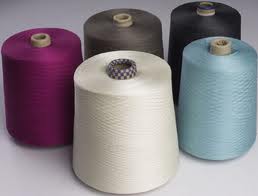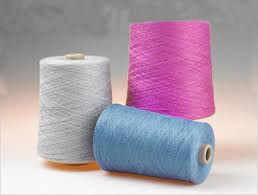| |

Kianco Reeled Silk Yarn,
Reeled, or filament silk is the highest quality yarn and is very white and
shiny. First the cocoons are inspected and sorted, as only those with a perfect
shape can be used for the reeling procedure. Cocoons are soaked in warm water to
soften the gummy sericin. The silken strand from a single cocoon is too fine to
use alone, so individual filaments of 6-20 cocoons are unraveled at the same
time, travelling through a very small eye. The softened sericin dries, hardens
and binds the strands together to become one thread the size of a human hair.
The majority of reeled silks supply large industrial looms.
Reeled Yarn
|
|
|
yd/lb |
m/kg |
skein
weight |
 |
#0 |
Bombyx Silk |
1,450 |
2,900 |
50g (1.8oz) |
 |
8/2 |
Bombyx Silk |
2,800 |
5,630 |
80g (2.8oz) |
 |
Fine Cord |
Bombyx Silk |
3,100 |
6,230 |
80g (2.8oz) |

Spun
Silk Yarn,
The weak filament of the transparent silken envelope remaining from the
reeling process, and the damaged, discolored, or imperfectly shaped
cocoons become the raw material for lustrous, creamy colored spun silk
yarn. This cocoon "waste" must first have the sericin removed (degummed)
with soap and water. Next, the fiber is cut into uniform lengths and
carded to remove short tangled bits as well as the brown pupa inside the
cocoons. Combing lays all the fibers parallel in a sliver which is spun
into a shimmering yarn. Spun silk is the most familiar yarn made
Spun Yarn
|
|
|
yd/lb |
m/kg |
skein
weight |
 |
20/10 |
Bombyx Silk |
950 |
1,900 |
50–80g (1.8–2.8oz) |
 |
6 Strand Floss |
Bombyx Silk |
2,450 |
4,925 |
105-120g (3.6-4.2oz) |
 |
12/2 |
Bombyx Silk |
2,950 |
5,930 |
95-100g (3.3-3.5oz) |
 |
20/2 |
Bombyx Silk |
5,000 |
10,060 |
100g (3.5oz) |
 |
20/2 |
Bombyx Silk
on cones |
5,000 |
10,060 |
approx. 200g (7oz) cone |
 |
30/2 |
Bombyx Silk |
7,500 |
15,090 |
100g (3.5oz) |
 |
60/2 |
Bombyx Silk |
15,000 |
30,170 |
100g (3.5oz) |
 |
120/2 |
Bombyx Silk |
30,000 |
60,350 |
100g (3.5oz) |
 |
120/2 |
Bombyx Silk
on cones |
30,000 |
60,350 |
approx. 200g (7oz) cone |
| |

Tussah silkworms are
protected and harvested in jungles and forests by indigenous
peoples in Asia. These silkworms have rejected all attempts at
total domestication. Tussah fibers are a little coarser than the
cultivated Bombyx.
TUSSAH SILK
Tussah is the common name given to the Antherea silk producing
caterpillars and their silk. These silkworms have a different
diet from their Bombyx mori cousins. Whether they are reared in
the tropics or temperate climate the leaves they eat contain
tannin, the ingredient in tea that leaves a stain in your cup.
The natural color of tussah silk is a warm honey beige.
Tussah silkworms are protected and harvested in jungles and
forests by indigenous peoples in Asia. These silkworms have
rejected all attempts at total domestication. Tussah fibers are
a little coarser than the cultivated Bombyx.
Wild Silk
|
|
|
yd/lb |
m/kg |
skein
weight |

|
20/2 |
Tussah Peduncle |
4,100 |
8,248 |
100g (3.5oz) |

|
30/2 |
Tussah |
6,100 |
12,270 |
100g (3.5oz) |

|
30/2 |
Muga |
6,800 |
13,680 |
100g (3.5oz) |

Blend
Silk Yarn
As glorious as silk is, sometimes a marriage with other fibers is
practical and enhances both fiber types.
These unions can be made in two ways: blending fibers in the carding
process before it is spun into yarn or using a mixture of different
fibers in a woven item.
Silk Blends
|
|
|
yd/lb |
m/kg |
skein
weight |
 |
30/2 |
45% Angora Rabbit
55% Silk |
7,000 |
14,080 |
100g (3.5 oz) |

|
60/4 |
40% Bamboo
60% Silk |
8,200 |
16,495 |
100g (3.5
oz) |
 |
30/2 |
45% Tan Camel
55% Silk |
7,400 |
14,880 |
100g (3.5 oz) |

|
30/2 |
45% White
Camel
55% Silk |
7,400 |
14,880 |
100g (3.5
oz) |
 |
28/2 |
20% Cashmere
80% Silk |
7,600 |
15,280 |
100g (3.5 oz) |
 |
60/4 |
45% Cotton
55% Silk |
8,000 |
16,075 |
65-90g
(2.3-3.2oz) |
 |
60/4 |
45% Ramie
55% Silk |
7,500 |
15,090 |
100g (3.5 oz) |
 |
60/4 |
40% Wool
60% Silk |
6,400 |
12,860 |
200g (7oz) |
 |
32/2 |
45% Yak
55% Silk |
7,600 |
15,280 |
100g (3.5oz) |
|
|